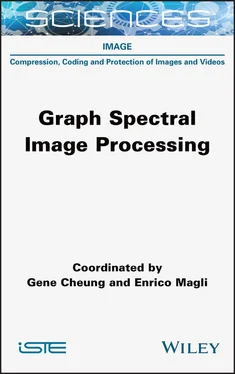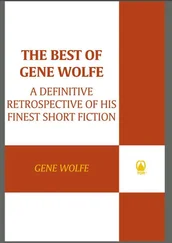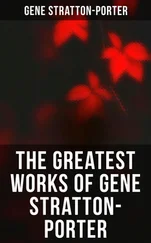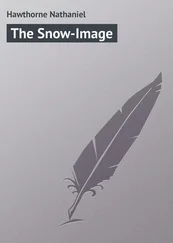8 Chapter 7Figure 7.1. Examples of 3D point clouds. The 3D point cloud in plot shows (a) a 3D Bunny model obtained by range scanners with some postprocessing and (b) one LiDAR sweep directly collected by Velodyne HDL-64E for autonomous driving Figure 7.2. Graph and graph signals for 3D point clouds. A K-nearest-neighbor graph is constructed to capture the pairwise spatial relationships among 3D points. The values of graph signals are reflected via color. For a color version of this figure, see www.iste.co.uk/cheung/graph.zip Figure 7.3. Low-pass approximation of the point cloud Bunny. Plot (a) is the original sampled point cloud with 1,797 points. Plots (b)–(d) show the low-pass approximations with 10, 100 and 1,000 graph frequencies Figure 7.4. Graph filtering for 3D point clouds. Low-pass graph filtering smooths the sharp transition in a graph signal, while high-pass graph filtering highlights the sharp transition. For a color version of this figure, see www.iste.co.uk/cheung/graph.zip Figure 7.5. A synthetic noisy point cloud with Gaussian noise σ = 0.04 for Quasimoto and one denoised result: (a) the ground truth; (b) the noisy point cloud; (c) the denoised result by Hu et al. (2020a) Figure 7.6. Dual problems of 3D point cloud downsampling and upsampling. For a color version of this figure, see www.iste.co.uk/cheung/graph.zip Figure 7.7. Local variation based downsampling enhances the contour information (Chen et al. 2018). For a color version of this figure, see Figure 7.8. Two auto-encoder frameworks for 3D point clouds. For a color version of this figure, see Figure 7.9. Graph topology learning and filtering improves the reconstruction of a 3D point cloud (Chen et al. 2019) Figure 7.10. An illustration of the GraphTER model for unsupervised feature learning (Gao et al. 2020). For a color version of this figure, see Figure 7.11. The architecture of the unsupervised feature learning in GraphTER. The representation encoder and transformation decoder are jointly trained by minimizing equation [7.33]. For a color version of this figure, see Figure 7.12. Visual comparison (Gao et al. 2020) of point cloud segmentation between GraphTER and MAP-VAE. For a color version of this figure, see
9 Chapter 8Figure 8.1. An example of the matrix W. For a color version of this figure, see www.iste.co.uk/cheung/graph.zip Figure 8.2. (a) The original 480 × 640 image with initial scribbles for three regions (blue, red and green). (b)–(d) The regions viewed against a uniform blue background, respectively. For a color version of this figure, see www.iste.co.uk/cheung/graph.zip Figure 8.3. An example of multiple images: two images of cells of benign and malignant types. For a color version of this figure, see www.iste.co.uk/cheung/graph.zip Figure 8.4. A one-dimensional example of five grid points for three regions segmentation (blue circle: image pixel; blue arrow : an edge between two grid point vertices; brown arrow: an edge from the source vertex to a grid point vertex; green arrow: an edge from a grid point vertex to the sink vertex; red arrow: an edge from one region to another region. For a color version of this figure, see www.iste.co.uk/cheung/graph.zip
10 Chapter 9Figure 9.1. Classification error rate (%) as a function of node degree k for the two datasets. For a color version of this figure, see www.iste.co.uk/cheung/graph.zip Figure 9.2. Classification error rate (%) as a function of labeling ratio for the two datasets. For a color version of this figure, see www.iste.co.uk/cheung/graph.zip Figure 9.3. Classification error rate (%) as a function of γ for the two datasets. Figure 9.4. Classification error rate (%) as a function of μ for the two datasets. For a color version of this figure, see www.iste.co.uk/cheung/graph.zip Figure 9.5. Classification error rate (%) as a function of label noise and the threshold τ for (a) MNIST dataset and (b) CIFAR10 dataset. We show classification error rate in color space as improvement when using two iterations, relative to the case with only one iteration; thus, a negative classification error rate means there is improvement due to the second iteration. For a color version of this figure, see www.iste.co.uk/cheung/graph.zip Figure 9.6. Classification error rate (%) as a function of label noise for the two datasets. For a color version of this figure, see www.iste.co.uk/cheung/graph.zip Figure 9.7. The block diagram of the unweighted graph generation scheme. V0(·) is a feature map function that reflects the node-to-node correlation. For a color version of this figure, see www.iste.co.uk/cheung/graph.zip Figure 9.8. The graph-based classifier and graph update scheme. The green and blue colors denote input and output, respectively. For a color version of this figure, see www.iste.co.uk/cheung/graph.zip Figure 9.9. The overall block diagram of the DynGLR-Net for r = 2. Given observations X, G-Net first learns an initial undirected and unweighted k-NN-graph by minimizing LossE. The resulting edge matrix E0 is used in the GLR iteration. The learnt shallow feature map f1(X) = {X, ZD(X)} is then used as an input to learn a CNNC1 network for assigning weights to the initial graph edges. Given a subset of potentially noisy labels, ˙Y, GLR is performed on the constructed undirected and weighted graph to restore the labels. The resulting restored labels are used in the following GLR iterations. Figure 9.10. CNNCr neural nets for CIFAR10 dataset: “pool/q/w” refers to a max-pooling layer with q = pool size and w = stride size. “x conv y/z” refers to a 1D convolutional layer with y filters, each with kernel size x and stride size z. “fc x” refers to the fully connected layer with x = number of neurons. “reshape x” refers to a reshape layer to transform the size of the input to x. “avg” refers to the global average-pooling layer (Lin et al. 2013). For a color version of this figure, see www.iste.co.uk/cheung/graph.zip Figure 9.11. CNNHU neural nets for the CIFAR10 dataset. For a color version of this figure, see www.iste.co.uk/cheung/graph.zip Figure 9.12. The magnitude of the GFT coefficients for the CIFAR10 dataset using sufficient data under 30% label noise level. The density of each eigenvalue λ across all experiments on the testing sets is represented through color maps. The top row shows the result after initialization and before GLR (G-Net output) and the second and third row show the result after the first (r = 1) and the second iteration (r = 2), respectively. For a color version of this figure, see www.iste.co.uk/cheung/graph.zip
11 Chapter 10Figure 10.1. Point cloud classification network (Simonovsky and Komodakis 2017). The network outputs the classification score vector y ∈ Rc, where c is the number of classes. GCONV: graph convolution operation; BNORM: batch normalization; FC: fully connected layer. For a color version of this figure, see www.iste.co.uk/cheung/graph.zip Figure 10.2. Point cloud segmentation network (Wang et al. 2019). The network outputs the per-point classification scores Y ∈ RN×p for p semantic labels. ⊕: concatenation. For a color version of this figure, see www.iste.co.uk/cheung/graph.zip Figure 10.3. Part segmentation results for chairs, lamps and tables. Figure from (Wang et al. 2019). For a color version of this figure, see www.iste.co.uk/cheung/graph.zip Figure 10.4. Image denoising network. Figure from (Valsesia et al. 2019a). For a color version of this figure, see www.iste.co.uk/cheung/graph.zip Figure 10.5. Graph-convolutional layer. Figure from (Valsesia et al. 2019a). For a color version of this figure, see www.iste.co.uk/cheung/graph.zip Figure 10.6. Extract from Urban100 scene 13, σ = 25. Left to right: ground truth, noisy (20.16 dB), BM3D (30.40 dB), DnCNN (30.71 dB), NLRN (31.41 dB), GCNN (31.53 dB). Figure from (Valsesia et al. 2019a) Figure 10.7. Receptive field (green) of a single pixel (red, circled in purple) for the three graph-convolutional layers in the LPF1 block with respect to the input of the first graph-convolutional layer in the block. Top row: gray pixel on an edge. Bottom row: white pixel in a uniform area. Figure from (Valsesia et al. 2019a). For a color version of this figure, see www.iste.co.uk/cheung/graph.zip Figure 10.8. Generative adversarial network. A generator G maps a latent vector z into a sample ĵ of the data distribution. The discriminator D can be interpreted as measuring the optimal transport cost between the true data and the generated data distributions. For a color version of this figure, see www.iste.co.uk/cheung/graph.zip Figure 10.9. Graph-convolutional GAN generator. The graph-convolutional and upsampling layers use a k nearest neighbor graph computed from the feature vectors at the input of the layer. For a color version of this figure, see www.iste.co.uk/cheung/graph.zip Figure 10.10. Generated point clouds. For a color version of this figure, see www.iste.co.uk/cheung/graph.zip Figure 10.11. Graph-convolutional variational autoencoder for shape completion. Figure from (Litany et al. 2018). For a color version of this figure, see www.iste.co.uk/cheung/graph.zip Figure 10.12. Examples of completed shapes. Figure from (Litany et al. 2018). For a color version of this figure, see www.iste.co.uk/cheung/graph.zip
Читать дальше












